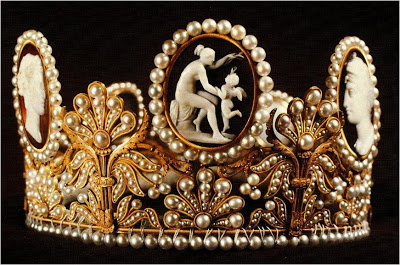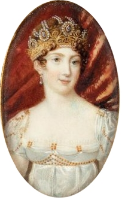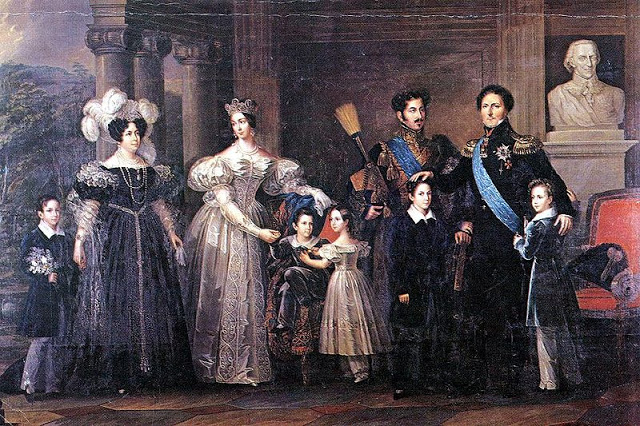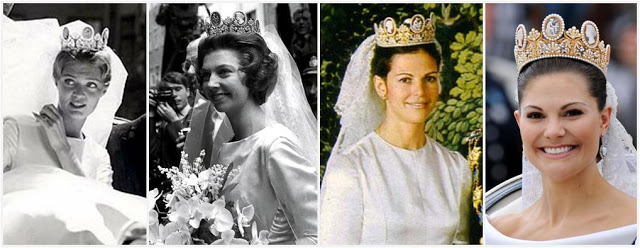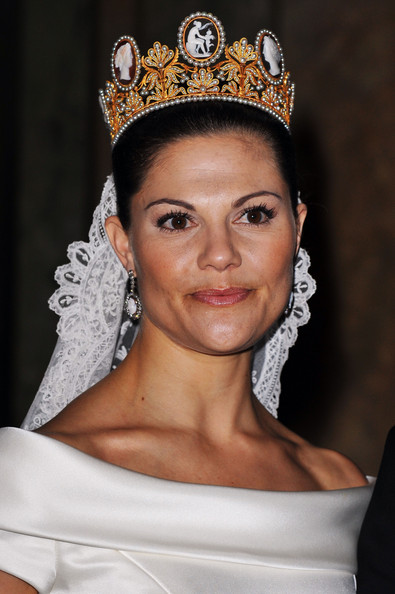The Swedish Cameo Tiara
/Princess Victoria of Sweden in the Cameo Tiara during her 2010 wedding
The Swedish tiaras are some of the oldest still in use, and the cameo tiara is one of them. Brides of the Swedish royal family have traditionally worn the Cameo Tiara as their wedding crown for decades and it was again in the spotlight when it was worn by princess Victoria of Sweden at her wedding to Daniel Westling on the 19th of June, 2010; however, the history of the tiara goes back much further..
Detail, Jacques-Louis David's The Coronation of Napoleon (1807) {Source}
In 1804, Napoléon Bonaparte was crowned emperor at the Cathedral of Notre Dame in Paris and his wife, Joséphine, was crowned empress. Joséphine was born in Martinique, the daughter of a wealthy Creole planter. She had previously been married to Alexandre de Beauharnais, a French aristocrat who had been guillotined during the Reign of Terror.
With her new title came a need to amass a vast collection of jewelry befitting that title. Among them was a parure (set) of cameo (a design, carved in relief, into a hard stone or shell) jewels, apparently made for her by her husband's court jeweler, Marie-Étienne Nitot. The set included a grand tiara in gold set with pearls and large Neo-Classical style cameos. It also included a necklace, a bracelet, and a pair of earrings. Cameos were quite popular during the time, especially those depicting classical mythological imagery. The style of the age was heavily influenced by the Ancient Roman Republic and its many archaeological treasures, which were being rediscovered starting in the 18th century.
It is interesting to note that the seven cameos used in this tiara were actually made first and were not intended to go together which is why they are all different in size and color.
Anne-Louis Girodet's portrait of Hortense de Beauharnais {Source}
Joséphine had two children, Eugène and Hortense, with her previous husband Alexandre; however, she was not able to provide Napoléon with a biological heir to the French throne. At around 1810, he divorced her and married Marie Louise of Austria, daughter of the Holy Roman Emperor. Joséphine relocated to the Château de Malmaison near Paris, taking her jewelry along with her.
In 1812 Joséphine loaned the cameos to her daughter, Hortense, who had briefly been Queen of Holland during the first decade of the nineteenth century. Hortense wore the cameos in a portrait painted by Anne-Louis Girodet. This is the first known depiction of the cameos.
Joséphine died of pneumonia in 1814. As was the custom, an inventory of her jewels was taken at the time of her death, but historian Trond Norén Isaksen noted the cameo parure was not included in this inventory. Exactly what happened to the cameos after her death is a bit unclear. Writer Vincent Meylan argues that her son, Eugène, received them when he and his sister Hortense were given their mother's jewels to divide. His evidence for this claim may be sound as the set reappears again in the line of Joséphine's son Eugène.
Eugène married Princess Augusta of Bavaria in a dynastic wedding eight years earlier at the behest of Napoléon, and by 1814 he was living in Munich at the court of his father-in-law with Augusta and their children. Eugène and Augusta's eldest daughter, Joséphine of Leuchtenberg, married Crown Prince Oscar of Sweden and Norway in 1823. Her marriage was also a dynastic one, having been arranged by Oscar's father, King Carl XIV Johan. Interestingly though Oscar is a Swedish prince, his family's roots are just as French as Joséphine's. His father was born Jean Bernadotte and served as a Marshal in the Empire under Napoléon prior to being elected as Sweden's future king. Oscar's mother, Désirée Clary, had been engaged to Napoléon until he met Joséphine de Beauharnais; in Sweden, she is known as Queen Desideria.
It is very likely that Joséphine of Leuchtenberg received her grandmother's cameo parure as a wedding gift from her father, taking the set with her to Stockholm. Upon her marriage she would be known by the Swedish version of her name: Josefina.
Fredric Westin's Bernadottes of Sweden 1837 {Source}
In this 1837 painting by Fredric Westin, the Swedish royal family is pictured, including King Carl XIV Johan, Queen Desideria, Crown Prince Oscar, Crown Princess Josefina, and their five children, Prince Carl, Prince Gustaf, Prince Oscar, Princess Eugenie, and Prince August. In the portrait, Josefina is depicted wearing her grandmother's cameo tiara.
In the portrait depicting an aging Josephina (circa 1890's) we again can see the tiara in all its glory.
Queen Josefina of Sweden by Bertha Valerius {source}
When Josefina died in Stockholm, the cameo parure was inherited by her only daughter, Princess Eugenie. Eugenie (a gifted artist) never married, but instead devoted her life to artistic pursuits and charitable causes. Upon her death, the cameos are inherited by her nephew, Prince Eugen. Like his aunt before him, Eugen was also a gifted artist and also never married.
Eugen often lent the cameos them to another member of the Swedish royal family: Crown Princess Margareta who was the wife of Eugen's nephew, Crown Prince Gustaf Adolf. Margareta donned the tiara to wear at the wedding of her husband's cousin, Count Carl Bernadotte af Wisborg. Famously she went into her children's nursery before leaving for the wedding, and gave them a history lesson by showing them a tiara that had been worn by Empress Joséphine of France.
In 1932 Prince Eugen gave the cameo parure to another Swedish royal, Princess Sibylla of Saxe-Coburg and Gotha, on the occasion of her marriage to Prince Gustaf Adolf, the eldest son of Crown Prince Gustaf Sibylla in turn lent it to her sister-in-law, the future Queen Ingrid of Denmark, for a costume ball where she dressed as Queen Josephina.
Left to Right: Queen Josephina, Crown Princess Margareta, Princess Ingrid (later Queen of Denmark), Princess Sibylla
Queen Silvia in the Cameos
While the parure was still in Sibylla's posession, a family tradition began. The Cameo Tiara began to be used as a wedding crown. Two of Queen Sibylla's used it for their weddings: Princess Birgitta in 1961 and Princess Désirée in 1964. In 1972 Princess Sibylla died of cancer in Stockholm, leaving the cameo parure to her son, Prince Carl Gustaf. Carl Gustaf is crowned king in 1973 and in 1976 when he married Silvia Sommerlath, she carried on the tradition.
The cameos and the tiara in particular are now shared with the first of her daughters to marry, Crown Princess Victoria in 2010.
Left to Right: Princess Birgitta, Princess Désirée, Queen Silvia, Crown Princess Victoria
On a final note, it is not uncommon to see tiara remade over time and one will easily see the incarnations of the tiara over the years to suit the styles of the time and the taste of the wearer. It is, however remarkable that such a beautiful piece of history exists and that it is still in use.
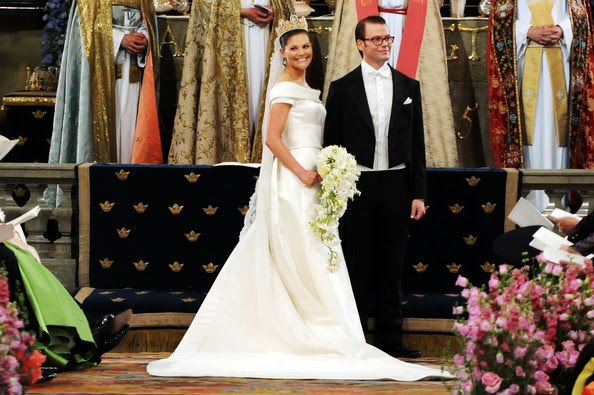
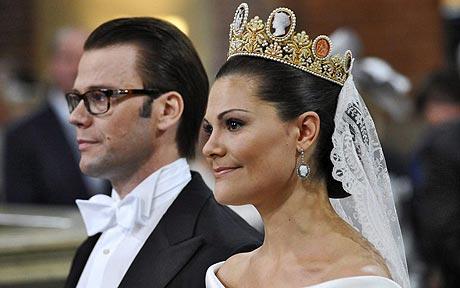
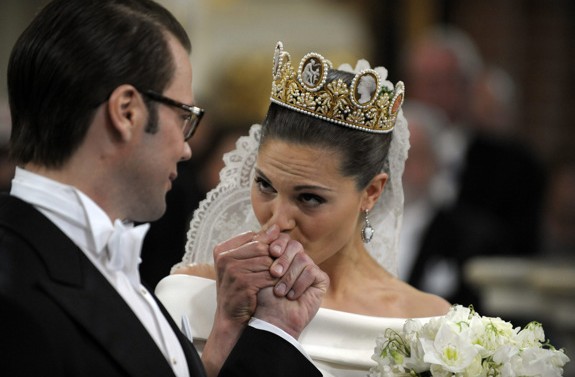
Kathleen Marino MA, GG, NAJA
With special thanks to The Royal Order of Sartorial Splendor and The Court Jeweller
